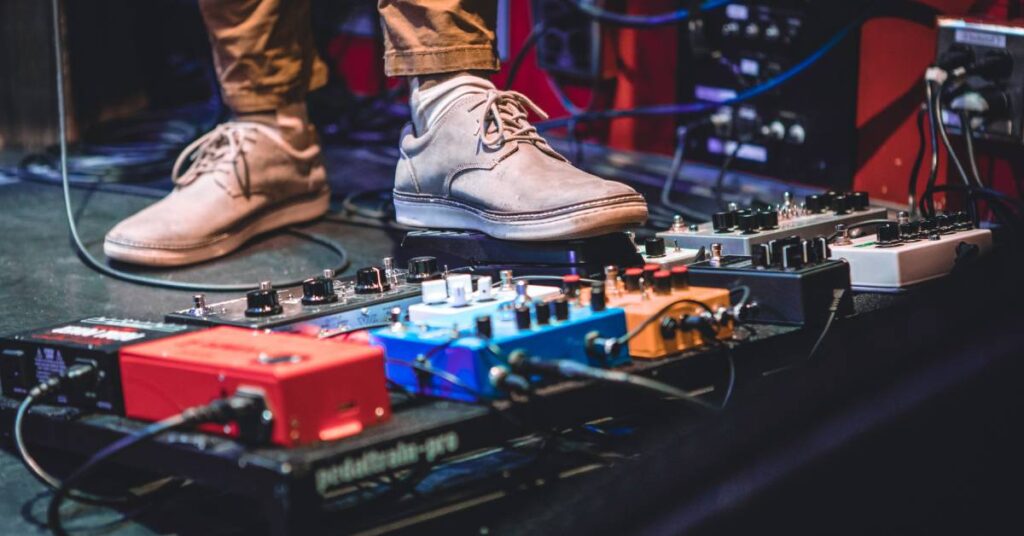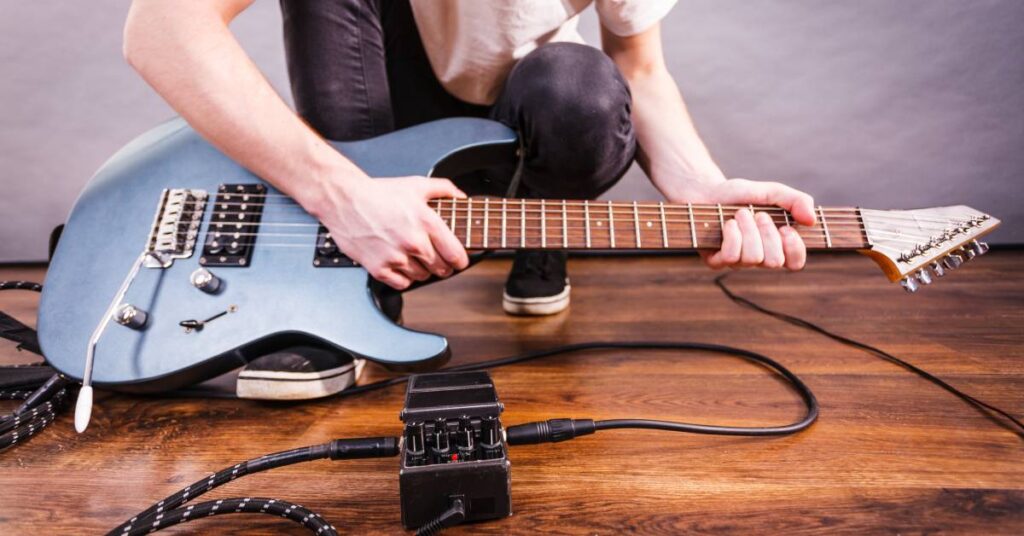
Have you ever watched your favorite guitarist effortlessly switch between effects and wondered how they do it? The secret lies in the guitar effects pedal!
Whether you’re an aspiring musician or a seasoned player, choosing the right effects pedal can transform your sound and performance. These eight tips for picking out the right guitar effects pedal will help you understand the features to look for and make an informed decision. Get ready to unlock new dimensions in your music!

Understanding Guitar Effects Pedals
What Is a Guitar Effects Pedal?
A guitar effects pedal allows guitarists to control various effects and functions of their equipment hands-free. This foot pedal rests on the ground and enables seamless transitions between effects and channels. It’s an indispensable accessory for live performances and studio sessions.
Effects pedals come in various forms, including single-function and multi-function models. Single-function effects pedals might control simple tasks like toggling an effect on or off. Multi-function effects pedals can handle complex tasks, such as switching between different amp channels or controlling multiple effects simultaneously.
Types of Guitar Effects Pedals
The different types of guitar effects pedals serve unique purposes:
- Distortion/Overdrive: Toggle between clean and distorted tones, perfect for varying intensity during a performance.
- Reverb: Control the depth and presence of reverb effects to create a richer sound or simulate various environments.
- Delay: Activate delay effects that add echoes and depth to your playing while enhancing solos and rhythm parts.
- Chorus: Switch on chorus effects to create a fuller, shimmering sound and add texture to your music.
- Flanger: Engage flanger effects for a sweeping, jet-like sound that adds movement and interest to your playing.
- Wah-Wah: Control a wah pedal effect for expressive articulation, making your solos stand out.
- Looper: Activate loop recording functionalities, layer sounds, and build complex compositions live.
- Tuner: Enable a built-in tuner function to ensure your instrument is ready for each performance.
- Channel Switching: Switch between different amplifier channels to access a wide range of tones.
- Expression Control: Use expression pedals to control parameters such as volume and effect depth in real time.
Understanding these types can help you make an informed choice when setting up your play sessions.

8 Practical Tips for Choosing an Effects Pedal
1. Assess Your Needs and Playing Style
Are you primarily a live performer, or do you spend more time in the studio? Do you need to control multiple effects simultaneously, or is simple channel switching sufficient?
If you’re a live performer, a durable and reliable effects pedal with multiple functions can enhance your stage presence and performance. For studio musicians, a pedal that offers precise control over effects and settings can streamline the recording process.
2. Try Before You Buy
Whenever possible, try out different effects pedals before purchasing. Head to your local music store, and test various models to get a feel for their build quality, responsiveness, and ease of use. This hands-on experience can help you determine which effects pedal best suits your needs.
If you can’t try before you buy, read reviews and watch demo videos online to gather insights from other musicians who have used the pedal you’re considering.
3. Check Durability and Build Quality
When choosing an effects pedal, durability should be a top priority. Look for models made with high-quality materials, such as metal casings, which can withstand frequent use. A sturdy effects pedal will last long and prove reliable for your performance.
Pay attention to the build quality of the switches. They should feel solid and responsive underfoot. Avoid pedals with flimsy or wobbly buttons, as they will likely stop working over time.
4. Verify Compatibility With Your Gear
Not all effects pedals are compatible with every setup. Before making a purchase, ensure that the pedal you’re considering is compatible with your amplifier, effects pedals, or any other equipment you use. Check the manufacturer’s specifications and guidelines to avoid compatibility issues.
Some effects pedals work with specific brands or models, while others offer universal compatibility. If you have multiple pieces of equipment, a versatile effects pedal that can work across different devices will be the best investment.
5. Consider the Number of Functions and Buttons
Consider how many functions your effects pedal will control. If you only need to switch between two channels, a dual-button effects pedal might suffice. However, a multi-button pedal will be more suitable if you require more extensive control over multiple effects and settings.
Think about your current setup and future needs. Investing in a effects pedal with many buttons and functions can provide more flexibility and room for growth as your playing style evolves.
6. Set a Budget
Effects pedals come in a wide range of prices, from affordable single-button models to high-end multi-function units. Determine your budget, and look for an effects pedal that offers the best combination of features, durability, and compatibility within your price range.
Remember that investing in a high-quality effects pedal can pay off in the long run, providing reliable performance and enhancing your overall playing experience.
7. Tailor to Your Play Style
Your play style obviously influences the type of guitar effects pedal you should buy. Different genres and performance contexts demand various levels of control and flexibility. For instance, if you frequently play rock music, you might benefit from a multi-function effects pedal that allows for rapid switching between distortion, reverb, and delay effects to match the dynamic nature of the music.
Conversely, acoustic performers might prioritize simpler setups, needing just volume control or a tuner function. Ultimately, understanding your play style can help you choose an effects pedal that supports your performance.
8. Find Your Brand
Several brands offer unique guitar pedals for sale. Here are a few popular ones to consider:
Boss
Renowned for its reliable pedals, Boss offers a range of effects pedals suitable for various effects and amp control. These products are known for durability and intuitive designs.
Dunlop
Famous for its wah-wah pedals, Dunlop produces high-quality effects pedals that cater to both live and studio settings. It is known for crafting pedals that provide exceptional control and responsiveness.
Line 6
A pioneer in amp modeling and effects, Line 6’s effects pedals integrate seamlessly with its gear, benefitting advanced players who demand flexibility.
Mooer
Known for its compact and affordable pedals, Mooer provides versatile effects pedals that are suitable for musicians looking to add functionalities without breaking the bank.
TC Electronic
This brand is iconic for its excellent effects and loopers, featuring effects pedals that allow for creative routing and control. They are perfect for innovative musicians.
Fender
As a legendary guitar brand, Fender makes effects pedals that enhance its amplifiers and meet the needs of discerning players.
Exploring these brands will help you find an effects pedal that aligns with your needs and playing style.
Take Your Playing to the Next Level
Picking out the right guitar effects pedal can change your sound and performance for the better. With these tips, you’ll be ready to hit the studio or stage! Try out different models, read reviews, and set a budget before making a purchase. With the right effects pedal, you’ll discover creative possibilities and take your musical artistry to the next level!
